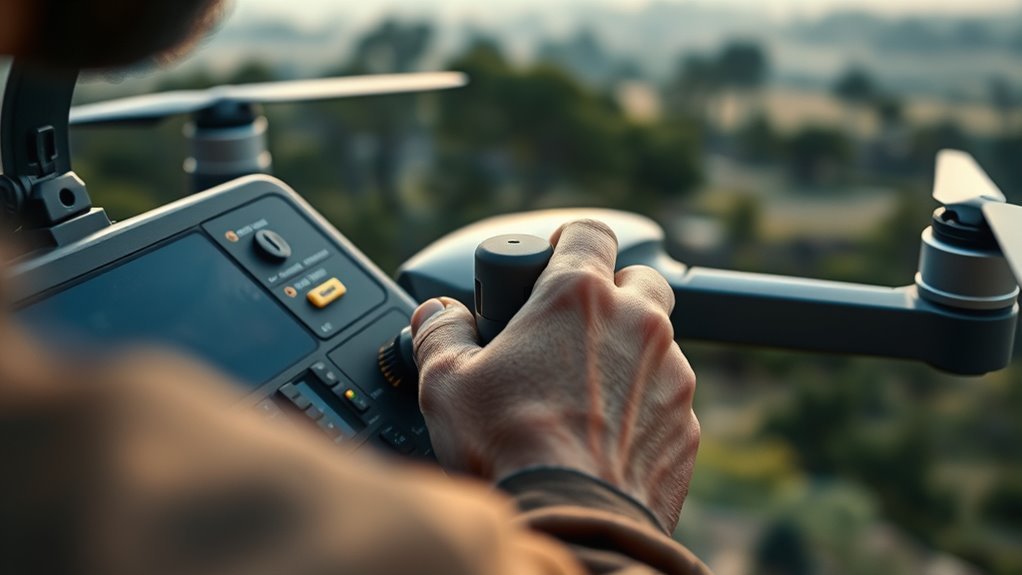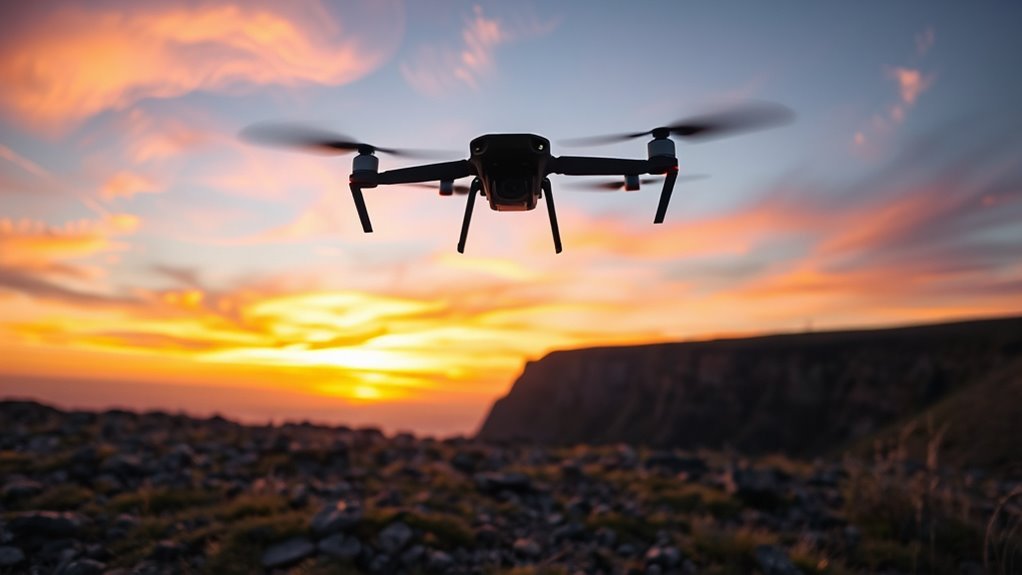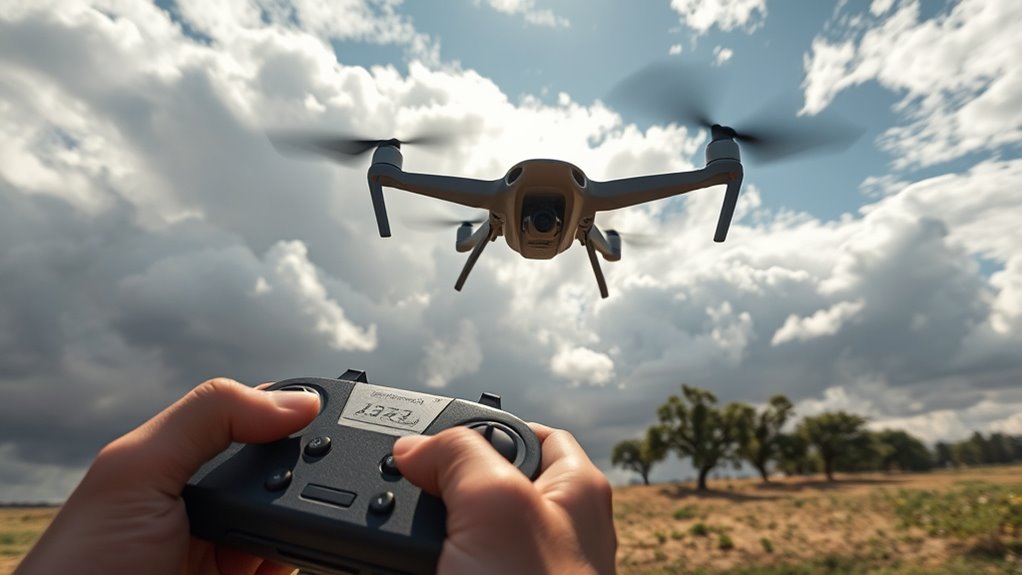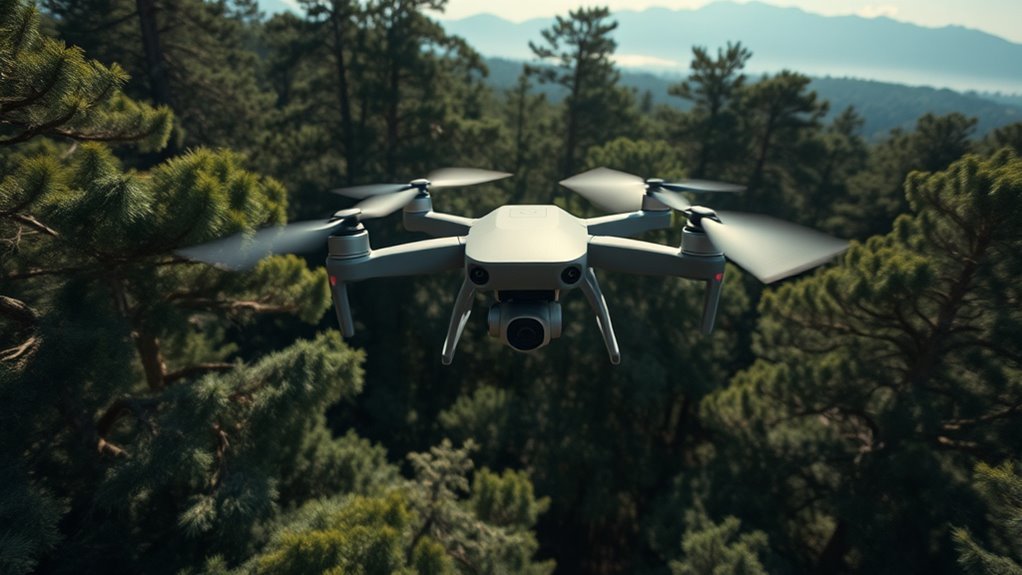Drones can be hard to fly due to intricate controls and varying flight techniques. You’ll face environmental challenges, like unpredictable wind and terrain, which can impact stability. Managing battery life is essential, as power drains faster in adverse conditions. Additionally, avoiding obstacles requires split-second decision-making and spatial awareness. Each flight demands precise control and careful planning to navigate hazards effectively. By understanding these complexities, you’ll enhance your skills and improve your flying experience.
Understanding Drone Controls

Understanding drone controls is essential for effective operation, as mastering just a few key elements can greatly enhance your flying experience. Start with joystick calibration, ensuring your inputs translate accurately. Adjusting control sensitivity can notably affect drone responsiveness, allowing for precise maneuvers. Familiarize yourself with various flight modes—each offers unique capabilities suited for different skill levels. The user interface is critical; a well-designed layout can streamline control schemes and enhance your overall experience. Keep an eye on software updates, as they often improve remote connectivity and introduce new features. For beginners, following tutorials can build a solid foundation, while advanced users can explore complex maneuvers. Mastering these controls empowers you to release your drone’s full potential. Additionally, understanding how motor power influences thrust and acceleration can further enhance your flying capabilities. Furthermore, knowing about advanced navigation systems can help you adapt to environmental conditions that may affect flight.
Mastering Flight Techniques

While flying a drone can seem intimidating at first, mastering flight techniques is essential for achieving ideal performance and safety. Understanding aerodynamic principles enhances your ability to control the drone, ensuring flight stability. Practicing specific maneuvers will help you respond effectively to various situations. Additionally, being aware of environmental conditions affecting flight range can significantly improve your overall flying experience. Being mindful of battery capacity is crucial, as it directly influences how long you can maintain flight before needing to land.
| Technique | Description | Benefits |
|---|---|---|
| Hovering | Maintaining a fixed position | Improves stability and control |
| Ascending/Descending | Vertical movement control | Enhances spatial awareness |
| Turning | Rotational control | Aids in maneuvering tight spaces |
| Forward Flight | Moving in a straight line | Increases efficiency and range |
Navigating Environmental Challenges

As you navigate the complexities of drone flight, environmental challenges can greatly impact your performance and safety. Terrain variability presents a significant hurdle; uneven landscapes, such as hills or dense forests, can obstruct your line of sight and disrupt signal transmission. You’ll need to adjust your flight path accordingly, ensuring your drone maintains a stable altitude while avoiding potential crashes. Additionally, wildlife interference can pose unexpected risks. Birds, for instance, may perceive your drone as a threat, leading to aggressive behavior that could result in collisions. Staying aware of these environmental factors is vital for a successful flight. By understanding and anticipating terrain and wildlife dynamics, you can enhance your operational freedom and mitigate risks during your drone missions.
Managing Battery Life and Power
Effective management of battery life and power is essential for maximizing your drone’s operational efficiency. To achieve this, you need to implement effective battery management strategies that monitor power usage in real-time. Start by calibrating your battery to guarantee accurate readings and avoid unexpected shutdowns. Utilize power conservation techniques, like reducing flight speed and minimizing altitude changes, to extend flight time. Additionally, always keep an eye on temperature fluctuations, as extreme conditions can affect battery performance. Regularly cycle your batteries to maintain their health, and avoid over-discharge, which can lead to permanent damage. By prioritizing these practices, you’ll enhance your drone’s endurance, allowing you to explore more freely and fully enjoy the possibilities of aerial navigation. Moreover, understanding battery capacity is crucial, as it directly affects flight duration and performance consistency. Furthermore, consider the charging efficiency of your drone, as faster recharge times can significantly reduce downtime between flights.
Adapting to Weather Conditions
When flying drones, you must consider how weather conditions affect performance. Wind resistance can severely impact stability and control, while rain and moisture can compromise electronic systems. Additionally, temperature fluctuations can alter battery efficiency and motor function, making it essential to adapt your flying strategies accordingly.
Wind Resistance Challenges
Although many drone pilots are enthusiastic to take to the skies, adapting to wind resistance challenges is essential for ensuring stable flight. Understanding wind patterns and their impact on drone performance is vital. Strong winds can create turbulence effects that disrupt your drone’s stability, making control difficult. When flying in windy conditions, you must anticipate how these patterns will affect your drone’s lift and maneuverability. Adjusting your flight path and altitude in response to changing wind dynamics helps maintain stability. Familiarizing yourself with the drone’s specifications regarding wind resistance can enhance your flying experience. Ultimately, mastering these challenges not only improves safety but also allows you to enjoy the freedom of flight with confidence, regardless of the weather.
Rain and Moisture Effects
While many drone enthusiasts relish the thrill of flying, it’s crucial to recognize that rain and moisture can significantly impact your drone’s performance. Moisture accumulation can lead to several issues, primarily through rain interference. Understanding these effects can help you adapt effectively:
- Loss of Control: Rain can cause erratic behavior, making it harder to maintain stability.
- Electrical Failure: Water can seep into components, leading to potential short circuits.
- Battery Drain: Wet conditions can accelerate battery drain, reducing flight time.
- Camera Impairment: Moisture on lenses can distort images, hindering your ability to capture clear footage.
Being aware of these challenges can empower you to make informed decisions about when and where to fly, ensuring a more enjoyable experience.
Temperature Impact on Performance
Temperature plays a critical role in drone performance, as extreme heat or cold can affect various components and overall flight stability. When you fly in harsh conditions, temperature fluctuations can impact battery life and motor efficiency, leading to reduced flight times. In cold weather, batteries may lose capacity, decreasing thermal efficiency and causing your drone to struggle to maintain altitude. Conversely, high temperatures can cause overheating, risking damage to sensitive electronic parts. Adapting to these weather conditions is essential for peak performance. By understanding how temperature impacts your drone, you can take proactive measures, such as adjusting flight plans or monitoring battery health, ensuring you maintain control and achieve the freedom of flight you desire.
Avoiding Obstacles and Hazards
When you’re piloting a drone, spatial awareness becomes vital as you navigate through potential obstacles and hazards. Real-time decision-making is essential, especially when environmental conditions shift unexpectedly, affecting your flight path. Understanding these factors can greatly enhance your ability to operate safely and effectively. Additionally, being aware of signal strength is crucial, as it can be impacted by physical obstructions and weather conditions, influencing your drone’s operational range. The integration of advanced sensor technology in modern drones significantly improves obstacle detection and navigation capabilities.
Spatial Awareness Challenges
Although drones have revolutionized various industries, steering them safely requires a keen sense of spatial awareness to avoid obstacles and hazards. Here are some key challenges you’ll face regarding distance perception and spatial orientation:
- Obstacle Detection: Identifying and reacting to barriers in real-time is vital.
- Height Awareness: Understanding your drone’s altitude in relation to surroundings can prevent crashes.
- Movement Prediction: Estimating how objects will move in relation to your drone is essential for safe navigation.
- Environmental Factors: Wind, weather, and terrain can alter your spatial perception and affect flight paths.
Mastering these challenges enhances your ability to fly effectively, ensuring your drone operates safely and efficiently while granting you the freedom to explore new heights.
Real-Time Decision Making
Mastering spatial awareness is only part of the equation; effective real-time decision-making is vital for avoiding obstacles and hazards while flying a drone. You need to develop situational awareness that enables you to assess your surroundings rapidly. This involves real-time analysis of potential threats within the drone’s flight path. As you navigate, you’ll encounter various obstacles, such as trees, buildings, and other aircraft, necessitating quick reflexes and sound judgment. The ability to interpret data from onboard sensors and cameras is essential. When combined with your spatial awareness, this real-time decision-making empowers you to maneuver safely and confidently. Ultimately, honing these skills gives you the freedom to explore while minimizing risks, allowing for a more enjoyable flying experience.
Environmental Conditions Impact
While you may have developed strong spatial awareness and decision-making skills, environmental conditions can greatly impact your ability to avoid obstacles and hazards during drone flight. Understanding these factors is essential for effective navigation.
- Thermal Currents: Rising warm air can cause unpredictable drone movements, affecting stability.
- Altitude Effects: Higher altitudes may reduce lift and battery efficiency, impacting control.
- Wind Patterns: Sudden gusts can push your drone off course, necessitating quick adjustments.
- Visibility Conditions: Fog or rain can obscure your view, making obstacle detection challenging.
Learning From Mistakes and Improving Skills
When you fly a drone, mistakes are often inevitable, but they provide invaluable opportunities for growth. Engaging in mistake analysis helps you identify what went wrong and why, allowing you to pinpoint specific areas for improvement. For instance, if you misjudged wind speed, analyzing that mistake will enhance your understanding of environmental factors, thereby refining your decision-making skills. Embracing errors as part of your learning process fosters skill development, empowering you to fly with greater confidence and precision. Each flight offers a chance to experiment and adapt, further enhancing your piloting abilities. By systematically reviewing your performance, you’re not just learning to fly; you’re cultivating a deeper connection with the freedom that drone flying offers. Additionally, understanding the limitations of signal penetration challenges can help you avoid potential pitfalls during flight operations. The Exo X7’s GPS-assisted position hold feature can significantly aid in maintaining stability, allowing you to focus more on improving your piloting skills.
Frequently Asked Questions
What Types of Drones Are Easiest for Beginners to Fly?
When you’re starting out, beginner drones are your best bet. Look for user-friendly models with stability features and intuitive controls. They’ll help you spread your wings without feeling like you’re in over your head.
How Do I Choose the Right Drone for My Needs?
To choose the right drone for your needs, consider essential drone features like camera quality and flight stability. Evaluating these factors guarantees you’ll enjoy a smoother flying experience, giving you the freedom to explore your surroundings.
Are There Any Age Restrictions for Flying Drones?
Are there really age limits for flying drones? Yes, many countries impose restrictions, often requiring operators to be at least 13 or 16. Adhering to these safety guidelines guarantees safe, responsible flying while enjoying your freedom.
Can I Fly Drones Indoors Safely?
You can fly drones indoors safely, but it’s essential to follow safety precautions. Make certain the space is clear of obstacles and people, and consider the drone’s size and capabilities to avoid accidents.
What Are the Legal Requirements for Flying Drones?
You need to understand drone regulations and obtain flight permits before flying. Compliance guarantees safety and legality, allowing you to enjoy the freedom of flying while respecting airspace rules and protecting yourself from potential penalties.

